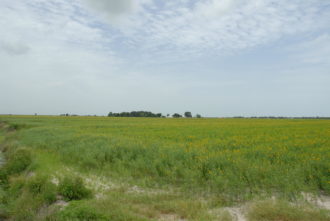BELLE GLADE, Florida – Florida vegetable farmers who grow cover crops as a green manure between their cash crops anecdotally tout the health benefits, but a two-year study by University of Florida has provided the research to back it up.
In a Southern Sustainable Agriculture Research and Education (SSARE) On-Farm Research Grant, University of Florida soil health expert Jehangir (Jango) Bhadha shadowed the cover crop practices of eight farmers across the state to measure the benefits of using cover crops (mainly cow pea and sunn hemp) as a soil amendment and nutrient source for subsequent cash crops.
In the project (OS18-114), “Assisting Vegetable Growers in Florida with Soil Health Evaluation Associated with Cover Cropping/Green Manure Practice During Summer,” researchers collected soil samples before and after the farmers’ cover cropping program and evaluated the change in soil health properties as a function of cover cropping looking at a host of soil health indicators, including physical, chemical and biological.
Results showed that cover crops provide a myriad of soil health benefits, such as:
- Increasing soil organic matter;
- Increasing water holding capacity;
- Decreasing soil pH, thereby improving nutrient efficiency and microbial activity;
- Increasing soil protein content, thereby storing more nitrogen and making it available to plants through mineralization.
- In some cases increasing phosphorus, one of the most important nutrients for plants next to nitrogen.
“There was a lot of enthusiasm from the growers to learn how their soils behaved when they practiced cover cropping during the fallow period,” said Bhadha, an assistant professor of soil, water and nutrient management at the Everglades Research and Education Center. “Growing cover crops is perhaps the most valuable strategy we can adopt to feed our soil, build up its fertility, and improve its structure with each passing season.”
Bhadha and his colleagues developed a six-module in-service training for University of Florida county and state Extension agents on Soil Health and Sustainability, which discusses the incorporation of cover crops in crop production for soil health and nutrition.
Published by the Southern Region of the Sustainable Agriculture Research and Education (SARE) program. Funded by the USDA National Institute of Food and Agriculture (NIFA), Southern SARE operates under cooperative agreements with the University of Georgia, Fort Valley State University, and the Kerr Center for Sustainable Agriculture to offer competitive grants to advance sustainable agriculture in America's Southern region. This material is based upon work that is supported by the National Institute of Food and Agriculture, U.S. Department of Agriculture, through Southern Sustainable Agriculture Research and Education, under sub-award number: OS18-114. USDA is an equal opportunity employer and service provider. Any opinions, findings, conclusions, or recommendations expressed in this publication are those of the author(s) and do not necessarily reflect the view of the U.S. Department of Agriculture.
